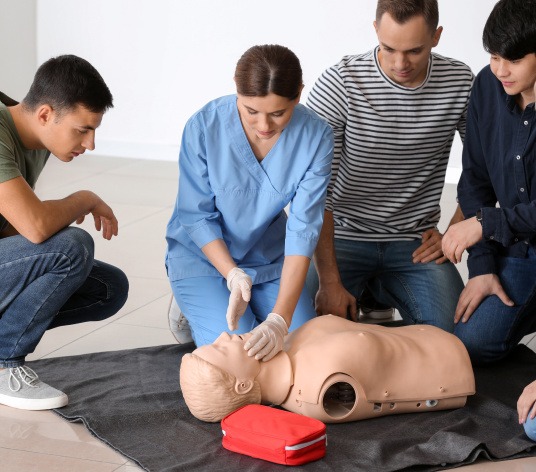Chapter 3: CPR – C-A-B
The American Heart Association (AHA) and Emergency Cardiovascular Care (ECC) guidelines were updated in 2010, changing the traditional A-B-C order of CPR (Airway–Breathing–Compressions) to C-A-B: Compressions–Airway–Breathing. This change was made because compressions were often delayed with the A-B-C sequence. With the C-A-B method, compressions start immediately, getting vital blood flow to the brain and organs faster.
Here’s how the C-A-B approach works (we’ll cover each step in more detail in the next chapters):
- C is for Compressions:
Give chest compressions at a rate of 100–120 per minute. The standard cycle is 30 compressions followed by 2 rescue breaths (30:2). Proper depth and full chest recoil are also important and will vary by age.
- A is for Airway:
Open the airway using the head-tilt, chin-lift method.
- B is for Breathing:
Give 2 rescue breaths after each round of compressions.
CPR During COVID-19 (2021 Interim Guidance)
With the rise of COVID-19, there were special updates to protect rescuers and reduce transmission risk—especially for laypeople who may not have access to personal protective equipment (PPE).
- Always put on PPE before beginning CPR.
- For adults: Perform at least hands-only CPR if a cardiac arrest is suspected. Covering the mouth and nose (with a mask or cloth) for both the rescuer and the victim may lower the risk of transmission if they’re not from the same household.
For children: Chest compressions are still recommended. Mouth-to-mouth can be considered. As with adults, covering both the rescuer’s and child’s nose and mouth is advised for non-household situations.
2025 Chest Compression Guidance
Updated CPR guidelines continue to recommend a compression rate of 100–120 per minute. Going faster or pressing too deep may reduce the heart’s ability to refill, and affect the outcome negatively.
Steady, controlled compressions are key to effective CPR.
Hands-Only CPR (2025 Update)
Hands-Only CPR is meant for teens or adults who suddenly collapse. It’s especially useful when someone has been trained in CPR before but may not remember every detail.
Here’s what to do:
- Call 9-1-1 and stay on the line until help arrives.
- Push hard and fast in the center of the chest. That’s it—just compressions, no rescue breaths.
This chapter in your Online CPR/AED and First Aid Combo Course explains the C-A-B sequence and recent updates so you can respond confidently and safely in a real-life cardiac emergency.
